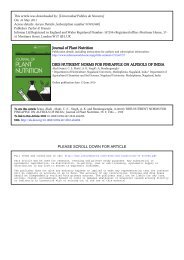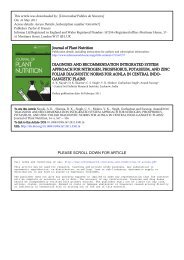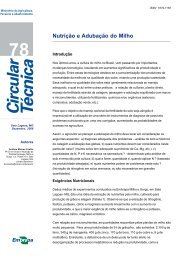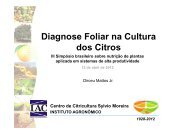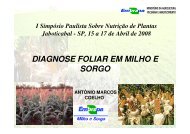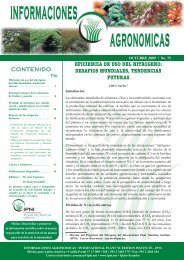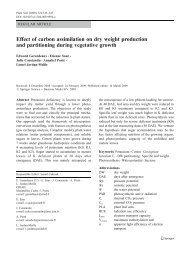Download PDF - Nutricao de Plantas
Download PDF - Nutricao de Plantas
Download PDF - Nutricao de Plantas
You also want an ePaper? Increase the reach of your titles
YUMPU automatically turns print PDFs into web optimized ePapers that Google loves.
160 Plant Soil (2008) 304:157–168Control of environmental conditionsThe inci<strong>de</strong>nt photosynthetically active radiation (PAR)was measured in the greenhouse using three amorphoussilicon cells (Solems, Palaiseau, France) as proposed byChartier et al. (1989). Air relative humidity wasmeasured with a relative humidity probe (HMP35AC,Vaisala, Helsinki, Finland). Air temperature wasmeasured using temperature probes (107, Campbellscientific, UK). All sensors were connected to adatalogger (21X, Campbell Scientific, UK). Measurementswere ma<strong>de</strong> every 15 min, but only hourlyaverage values were recor<strong>de</strong>d. Thermal time (TT in °Cdays) was calculated on a daily basis as follows:TT ¼ ðT max þ T min Þ=2 T bwhere T max and T min are the maximum and minimumhourly air temperature (in °C), respectively, and T b thebase temperature (10°C). Cumulative thermal time wascalculated by adding daily values.Average daily values of air temperature, inci<strong>de</strong>ntPAR and air relative humidity during the experimentwere 18.6°C, 8.3 MJ m −2 and 71%, respectively. Theaverage daily inci<strong>de</strong>nt PAR was relatively low sincethe experiment was carried out in October withoutadditional artificial light.CalculationsLeaf areaAreas (A, inm 2 ) of individual leaves were calculatedas followed (Bonhomme et al. 1982):A ¼ 0:75 L W for fully expan<strong>de</strong>d ðligulatedÞleavesA ¼ 0:5 L W for expanding leavesThe total leaf area per plant (LA in m 2 ) wascalculated by adding all individual leaf areas.Photosynthetically active radiation absorbed by plantsThe daily amount of PAR absorbed by plants (PARa, inMJ) was calculated as the product of the daily inci<strong>de</strong>ntPAR (in MJ m −2 ) and the total leaf area per plant (inm 2 ). Leaf absorbance is supposed to be equal to 1.Self-shading and mutual shading between plants wereneglected because of the low total area per plant andthe large distance between plants (approximately 1plant m −2 ). For daily calculations the leaf area per plantwas linearly interpolated between sampling dates.Radiation use efficiencyThe radiation use efficiency (RUE, in g MJ −1 ) wascalculated for each interval between sampling dates asfollows:RUE ¼ ðW n W n 1 Þ= ðcPARa n cPARa n 1 Þwith W n and W n−1 being the average plant dry biomass(in g) on dates n and n−1, respectively, and cPARa nand cPARa n−1 being the cumulated amount of PARabsorbed by the plant (MJ) on dates n and n−1respectively. Since RUE was calculated from averageplant biomass and absorbed PAR increments at theplant population level no replications were availableand no statistical tests could be performed on thisvariable.Leaf elongation rate (LER)The general shape of the curve of a maize leaf bla<strong>de</strong>length against thermal time from its initiation is sigmoid(Arkebauer and Norman 1995; Duran<strong>de</strong>tal.1995).The elongation rate gradually increases, levels out(quasi-linear elongation phase) and then gradually<strong>de</strong>creases. The first phase of elongation occurs whenthe leaf is hid<strong>de</strong>n by the sheaths of the lower leaves. Tomake the comparison easier between LER of differentleaf ranks and K treatments, we calculated the LERduring the quasi-linear elongation phase only. Onlydata when the leaf was between 20% and 90% of itsfinal leaf length were consi<strong>de</strong>red for LER calculations.For each leaf rank and K treatment the mean LER (inmm °C days −1 ) was calculated as the slope of leaflength against cumulative thermal time.Axile root elongation rate (RER)The root elongation rate (RER in mm °C days −1 )ofaxile roots was calculated using the successive inkmarks as proposed by Mollier and Pellerin (1999):RER ¼ðΔL br þ L unbr n L unbr n 1 Þ= ðTT n TT n 1 Þwith ΔL br being the distance (in mm) between the inkmarks drawn on the root on days n and n−1, L unbr n



